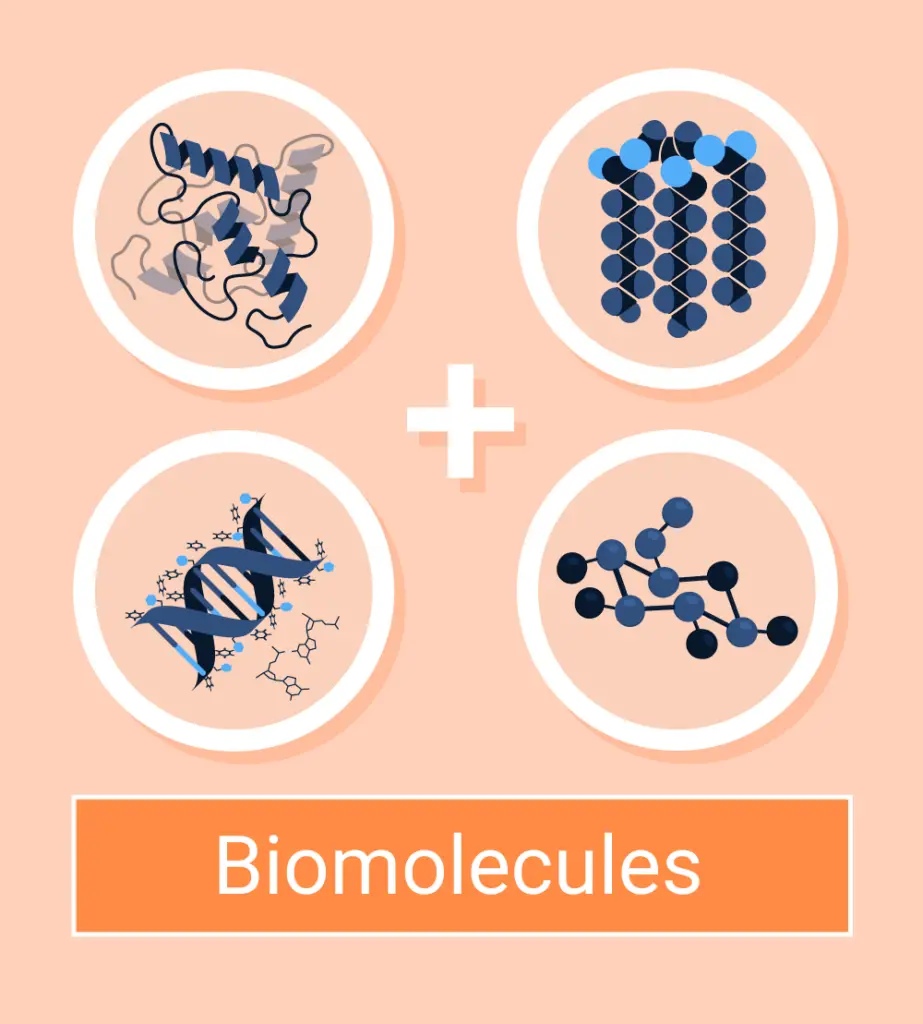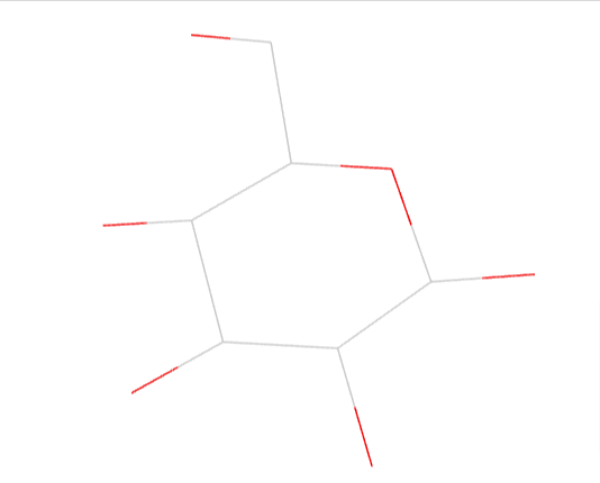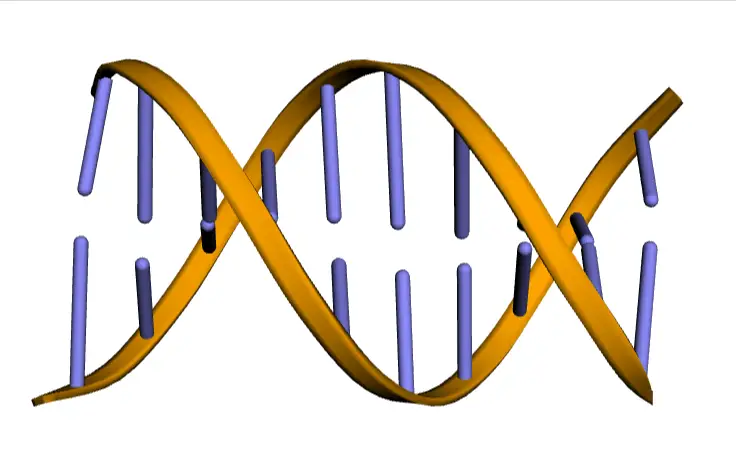Now we will discuss the chemicals that are building blocks of living systems and perform different metabolic reactions inside cells, biomolecules, and their types.
Table of Contents
What is Biomolecules:
In living systems, a major portion is made by nonliving biomolecules, but their integrated activity makes the organism live. In cellular metabolism, biomolecules are the main reactant and the product is also biomolecules so we can say that everything in living cells is either biomolecules or derivatives of biomolecules.
Knowledge about biomolecules is very important to understand the mechanism of different metabolic reactions that occur inside cells and the structure of cellular components.
Because the cells and their products are biomolecules, if we want to understand how cells act like living substances, we have to understand the activities of biomolecules.
The food we take to meet our energy is also different types of biomolecules and the products produced from living systems like different types of secretion are also biomolecules. The enzymes used in cells for increasing the reaction rate are also an example of biomolecules, the antibody in our immune system is also a special type of biomolecules.

Biomolecules and its Types:
Depending upon the chemical nature biomolecules can be divided into four major groups in living systems – carbohydrates, lipids, protein, and nucleic acids.
Carbohydrates:
Carbohydrates are chemically polyhydroxy aldehydes or ketone or their derivatives and they are made of carbon, oxygen, hydrogen and they are also known as sugar or saccharide because of their sweet taste.
They are the main components of various cellular structures like cell walls of plant cells are made of majorly cellulose which is an example of carbohydrates in which many monomeric units are present so they are known as polysaccharides.

The carbohydrates in which upon hydrolysis only one type of monomeric sugar is found is called monosaccharides while the carbohydrates in which 2 to 10 monomeric sugar units are present are known as oligosaccharides but when the number of monomeric sugar units in carbohydrates is more than 10 then it is known as a polysaccharide.
In our diet different carbohydrate-rich foods give us instant energy, for example, rice, corn is rich in carbohydrates which are digested by different hydrolase enzymes known as carbohydrates which cause the hydrolysis of complex carbohydrates into monomeric simple carbohydrates.
The simplest form of carbohydrates is glucose, which is again used in respiration. The glucose molecules break down to release metabolic energy to maintain different cellular activities in our body.
Protein:
They are polymers of different amino acids responsible for catalyzing most biochemical reactions as enzymes. Different structural proteins form the cellular structure and are synthesized in the ribosome.
The protein synthesis command is present in DNA and the RNA is formed from the DNA through the process of transcription. Then the ribosome reads the RNA and joins different amino acids according to the code on RNA to form the polymer of amino acids in the form of a polypeptide chain.
Lipids:
They are chemically ester made of glycerol and fatty acids which are major components of fat and oil and they have high calorific value. They present in cell membranes in the form of glycolipids and phospholipids and they are water-insoluble due to their hydrophobic nature.
Nucleic Acids:
They are polymers of nucleoside which are again made of a pentose sugar, nitrogen base, and phosphate group and they present in cells in the form of DNA and RNA. They store the genetic information in the nucleus and the RNA is very important for the expression of DNA by protein synthesis in the ribosome.

Reference: Biomolecules and Their Types
Related Topics to “Biomolecules and Their Types“:
| Important Functions of Amino Acids |
| Definition and Properties of Amino Acids |
| Structure and Function of Nucleic Acids |
What is the Importance of Biomolecules?
The structure and function of a living system is the result of mutual interaction among all the biochemicals and the source of energy in a living system also comes from different biochemicals.
How Many Types of Biomolecules are?
On the basis of chemical nature and their role in a living system, we can classify all the biomolecules into 4 categories – Carbohydrates, Proteins, Nucleic Acids, and Lipids.
What are the Characteristics of Biomolecules?
Biomolecules can be separated on the basis of their functional groups because they are organic chemicals and they form polymers made of the simple forms of biomolecules.
Which Types of Biomolecules Form Enzymes?
Generally, enzymes are made of proteins like pepsin, maltase, and other digestive enzymes. But some enzymes are non-proteinaceous like ribosome which is RNA (a nucleic acid).
Which Biomolecules are Responsible for carrying Genetic Information?
The gene present inside a chromosome is actually a piece of nucleic acid DNA and store the genetic information in the form of a gene. Both DNA and RNA are the basic elements in genetics.
Can We Prepare Biomolecules in Laboratory?
Yes, we can prepare them in laboratory present days but it was not possible in previous time and scientists thought that biomolecules are only produced in a living system, not in a laboratory.
From Where We Get Biomolecules?
We take food and we get all our requirements from the food to maintain our body. The chemicals present in food are actually biomolecules that help to maintain our living system.
Which Biomolecules are not Present in Foods?
Carbohydrates, proteins, and lipids are present in food as nutrients but the nucleic acids, DNA, and RNA we do not get directly from food, and for this reason, nucleic acids are not nutrients.
Which Biomolecule is Most Abundant on Earth?
Among all the biomolecules carbohydrates are found in the highest amount on the earth in the living system because most parts of a living cell are made of carbohydrates.
Which Biomolecule Comes First? RNA or Protein?
During the origin of life on our earth protein comes first not RNA, so we can say that life’s first molecule was protein but in previous times scientists considered RNA to be first.
Hi Everyone!!! Welcome to Imaluop. Imaluop always try to learn some new and he want to share to other people. Here we will try to learn various topics on Science, specially on Biological Sciences.
